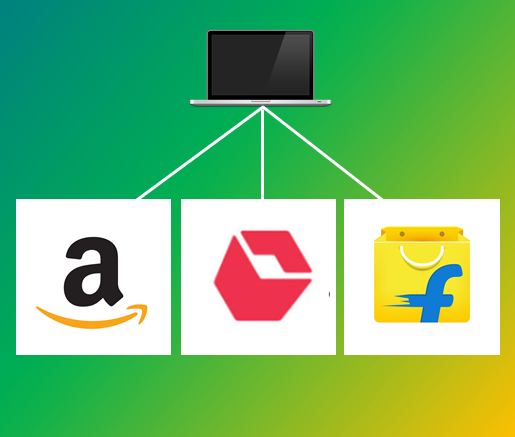
Christmas is just around the corner, and if you’re done and dusted with your Christmas shopping, then good on you. You can sit back and relax while the rest of us scramble with our last minute shopping. Since most shopping is online now, we’re going to be shelling out the big bucks for express delivery. But what happens when that delivery is delayed and it’s Christmas with no gifts?
You’re probably going to vent your feelings on social media in a long rant directed towards the e-commerce company. But would your voice be heard and would you concern be resolved? This got us wondering as to which e-commerce superstore delivered the best social customer care.
To answer that question, we chose 3 popular brands – Flipkart, Amazon India and Snapdeal. Manually analysing conversations seen in the past month on Facebook, and using Trooya’s Benchmarking feature, we evaluated their customer care on the following parameters:
Responses to product related issues: How does the brand respond to customers who have issues with the product that they have received
Responses to delivery and billing related issues: How does the brand respond to customers who have issues with their billing and delivery of their products
Average response time: What was the average time in which a brand issued a response to a customer
Average response rate: How many customer interactions did a brand respond to, from the total interactions it received for a specific duration of time
Before we proceed, please note that this article focuses only on the Facebook-based customer service performance of the selected brands.
Responses to product related issues:
Flipkart
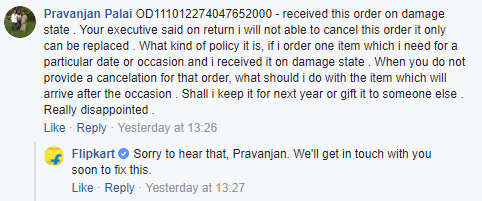
When looking at Facebook conversations about product related issues, we found that Flipkart replied to 86% of such grievances. They empathise with the customer and promise to get in contact to address and resolve the expressed concern.
Amazon India
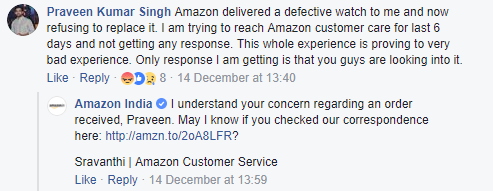
Amazon India had replied to 88% of all product related customer grievances. The brand empathizes with the disgruntled consumer in a professional and formal tone. The customer is then redirected to Amazon’s Message center, wherein each customer tends to receive updates or notifications from the Amazon India team.
Snapdeal
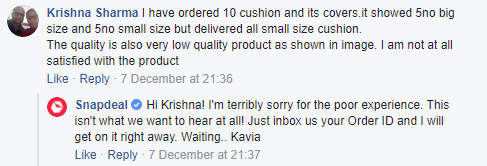
Snapdeal responded to 86% of customer grievances related to products. They usually issue a heavy apology to a customer as part of their acknowledgement. Additionally, they ask the customer to privately share the order details so they can begin working on the resolution.
Responses to delivery and billing related issues:
Flipkart
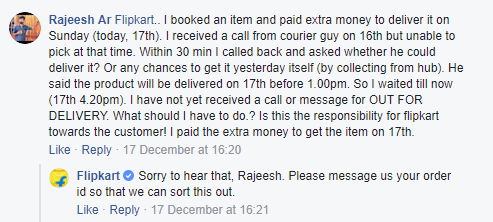
Flipkart responded to 80% of all billing and delivery related issues in our sample. They also tend to follow up with the customer to close the loop with a message like the one displayed below.
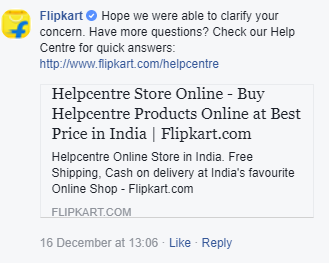
Amazon
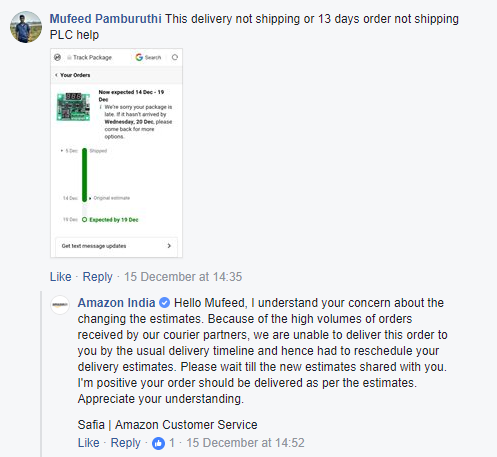
86% of all delivery and billing related issues on Facebook were tended to by Amazon India. Their responses are personalised and their tone is professional. The customer care executives sign-off with a whole signature. Amazon India also tends to close the loop wherever possible. For instance, while the above example shows the Amazon India team resolving a customer’s concern in their first level response itself, the below example shows them closing the loop after a series of messages with the customer.
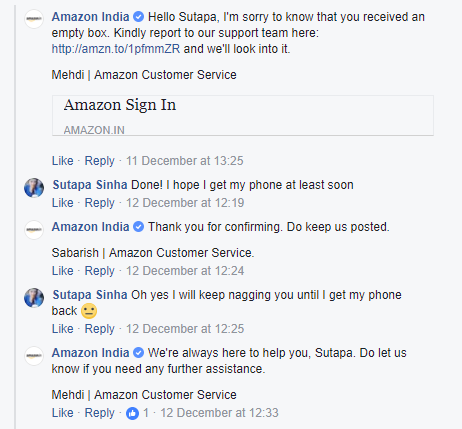
Snapdeal

From our manual analysis, we saw that 86% of all delivery and billing related issues on Facebook had a response from Snapdeal. They personalise their responses for every customer. They refer to them directly at the start of the conversation and every response has a personal sign-off from the social customer care executive.
Average Response Rate:
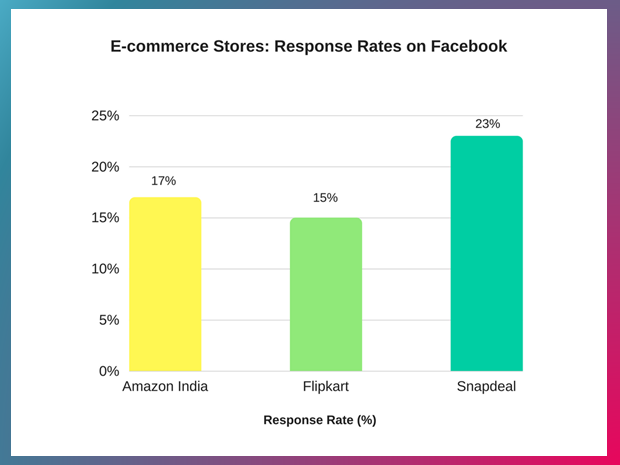
Using Trooya’s Benchmarking tool, we analyzed the average response rate of the 3 brands. The numbers reflect the percentage of customer conversations that the brand has replied to. Snapdeal replied to 23%, Amazon responded to 17% and Flipkart responded to 15% of customer conversations on Facebook. Note that, Response Rates are affected by the general and non-customer centric conversations which brands receive on their Facebook pages. A lower response rate can be indicative of the brand not responding to contest or reactions to published content, which understandably doesn’t always need a response.
Average Response Time:
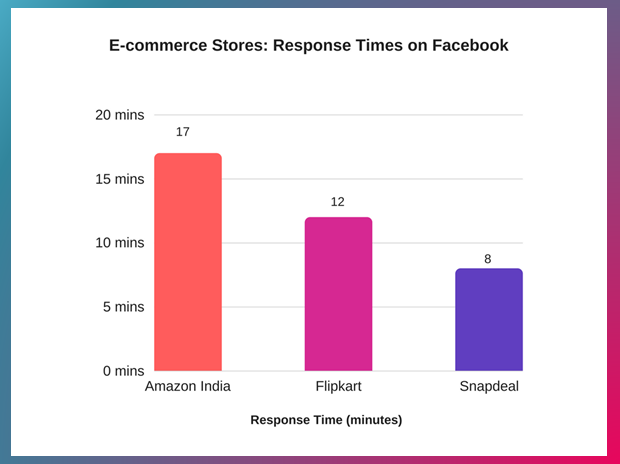
Using Trooya’s Benchmarking tool, we analysed the average response time of the 3 brands. An ideal response time is said to be around 30 mins. In comparison to that, all brands have excelled and are well ahead of the industry standard of 15 – 30 minute response times. In fact, the difference between the response times of the brands is marginal.
| Amazon India | Flipkart | Snapdeal | |
|---|---|---|---|
| Responses to product related issues | 4/5 | 4/5 | 4/5 |
| Amazon India responded to 88% of product related issues | Flipkart responded to 86% of product related issues | Snapdeal responded to 86% of product related issues | |
| Responses to delivery and billing related issues | 4/5 | 4/5 | 4/5 |
| Amazon India responded to 86% of delivery and billing related issues | Flipkart responded to 80% of delivery and billing related issues | Snapdeal responded to 86% of delivery and billing related issues | |
| Average response time | 5/5 | 5/5 | 5/5 |
| Amazon India has an average response time of 17 mins | Flipkart has an average response time of 12 mins | Snapdeal has an average response time of 8 mins | |
| Average response rate: | 1/5 | 1/5 | 2/5 |
| Amazon India has an average response rate of 17% | Flipkart has an average response rate of 15% | Snapdeal has an average response rate of 23% | |
| Weighted Average Score | 4.1 | 4.1 | 4.2 |
A few takeaways from the social customer service of these brands are:
1. Fusion or redirection and non-redirection: Amazon India employed an interesting strategy to manage customer care on their social media presence. When a customer shared a concern, they were first redirected to the Message Center available within each user’s personal Amazon account. Updates were shared on this portal. Simultaneously, updates were also shared with the customer on their social media post. In this way, they managed to resolve a customer concern while closing the loop at the same time. This strategy increases the perception of the brand being sensitive to their customer’s concerns.
2. Lightning quick response turnaround times: A turnaround time of 15 minutes is considered ideal, while that of 30 – 60 minutes is considered the standard. While writing this article, we observed how all of the aforementioned brands had achieved the ideal response time of around 15 minutes. Such a quick response time shows the customers that they’re valued and that someone is working on their concern. Brands must strive to achieve fast response times for their first level responses, and if possible, their overall response time too.
3. Long but relevant responses: The length of a response doesn’t matter as long as it helps resolve a customer concern. While researching for this piece, we saw lengthy responses. They were useful because they had detailed explanations about the customer’s concern. This approach isn’t visibly appealing, but it helps retain customer satisfaction by giving them clarity on their grievance.
If you liked this article and wish to read more of such analysis on social media customer service, do like and subscribe to our blog.
